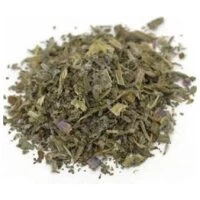Western Bulk Herbs – Cinquefoil
Western Bulk Herbs Cinquefoil
Five-leaf Grass is a creeping plant with large yellow flowers like the Silverweed, each one growing on its own long stalk, which springs from the point at which the leaf joins the stem.
—Description—The rootstock branches at the top from several crowns, from which arise the long-stalked root-leaves and thread-like, creeping stems, which bear stalked leaves and solitary flowers. These stem-runners root at intervals and as they often attain a length of 5 feet, the plant is rapidly propagated, spreading over a wide area. It grows freely in meadows, pastures and by the wayside.
The name Five-leaved or Five Fingers refers to the leaves being divided into five leaflets. Each of these is about 1 1/2 inch long, with scattered hairs on the veins and margin, the veins being prominent below. The margins of the leaflets are much serrated. In rich soils the leaflets are often six or seven. Out of a hundred blossoms once picked as a test, eighty had the parts of the corolla, calyx and epicalyx in fives, and the remaining twenty were in sixes.
Although the flowers much resemble those of the Silverweed, the two plants can readily be distinguished by the difference in their leaves. The flowers secrete honey on a ringlike ridge surrounding the base of the stamens. Insects alighting on the petals dust themselves with the pollen, but do not touch the stigmas, as the honey ring extends beyond. If they alight in the middle of the next flower, they dust the pollen against the stigma and cross-pollinate it. But the flower is often self-pollinated. The flowers close up in part in dull weather and completely at night, and it is then that the anthers touch the stigmas.
Bacon says that frogs have a predilection for sitting on this herb: ‘The toad will be much under Sage, frogs will be in Cinquefoil.’
It was an ingredient in many spells in the Middle Ages, and was particularly used as a magic herb in love divinations. It was one of the ingredients of a special bait for fishing nets, which was held to ensure a heavy catch. This concoction consisted of corn boiled in thyme and marjoram water, mixed with nettles, cinquefoil and the juice of houseleek.
In an old recipe called ‘Witches’ Ointment’ the juice of Five-leaf Grass, smallage and wolfsbane is mixed with the fat of children dug up from their graves and added to fine wheat flour.
[Top]
—Medicinal Action and Uses—stringent, febrifuge. The roots have a bitterish, styptic, slightly sweetish taste and have been employed medicinally since the time of Hippocrates and Dioscorides.
They were used to cure the intermittent fevers which prevailed in marshy, ill-drained lands, and especially ague.
Dioscorides stated that one leaf cured a quotidian, three a tertian, and four a quarten ague.
Culpepper says:
‘It is an especial herb used in all inflammations and fevers, whether infectious or pestilential or, among other herbs, to cool and temper the blood and humours in the body; as also for all lotions, gargles and infections; for sore mouths, ulcers, cancers, fistulas and other foul or running sores.
‘The juice drank, about four ounces at a time, for certain days together, cureth the quinsey and yellow jaundice, and taken for 30 days cureth the falling sickness. The roots boiled in vinegar and the decoction held in the mouth easeth toothache.
‘The juice or decoction taken with a little honey removes hoarseness and is very good for coughs.
‘The root boiled in vinegar, being applied, heals inflammations, painful sores and the shingles. The same also, boiled in wine, and applied to any joint full of pain, ache or the gout in the hands, or feet or the hip-joint, called the sciatica, and the decoction thereof drank the while, doth cure them and easeth much pain in the bowels.
‘The roots are also effectual to reduce ruptures, being used with other things available to that purpose, taken either inwardly or outwardly, or both; as also bruises or hurts by blows, falls or the like, and to stay the bleeding of wounds in any part, inward or outward.’
Robinson’s Herbal directs that the roots are to be dug up in April and the outer bark taken off and dried, the rest not being used.
To make the decoction, it is directed that 1 1/2 OZ. of the root be boiled in a quart of water down to a pint. This decoction is recommended not only as a remedy for diarrhoea, and of avail to stop bleeding of the lungs or bronchial tubes and bleeding at the nose, but as a good eyewash, as well as a gargle in relaxed sore throat.
The juice of the root, mixed with wheat bread, boiled first, is recommended as a good styptic.
A scruple of the powder in wine is the dose prescribed to cure the ague.
In modern Herbal Medicine, the dried herb is more generally now employed, for its astringent and febrifuge properties.
An infusion of 1 OZ. of the herb to a pint of boiling water is used in wineglassful doses for diarrhoea and looseness of the bowels, and for other complaints for which astringents are usually prescribed, and it is employed externally as an astringent lotion and as a gargle for sore throat.
Latin Name:
Potentilla erecta
Common Name:
Parts Used:
Properties:
Traditional Uses:
Internal Applications:
Topical Uses / Applications:
Culinary Uses:
Chemical Properties:
Folk Lore:
Cautions:
*Disclaimer: These statements have not been evaluated by the Food and Drug Administration. This product is not intended to diagnose, treat, cure or prevent any disease.
Resources:







Reviews
There are no reviews yet.